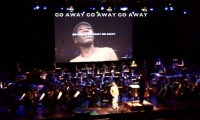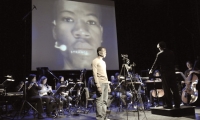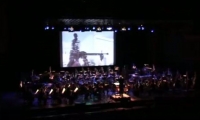29.01.2010 + 30.01.2010,
STRANGE NEWS
Josse DE PAUW, Rolf WALLIN
Arthur KISENYI, actor
ICTUS conducted by Georges-Elie Octors
... a work for actor, orchestra or ensemble, surround sound and video screen,
based on footage of child soldiers in DR Congo
>STRANGE NEWS Website
Théâtre National, Brussels (B)
Strange News represents a large work for the concert hall that deals with matters in the world around us. It is not a piece of ‘political art’ in the traditional sense, in which one often propagates against a clearly defined ‘enemy’ and proposes a solution for the problem, but rather as an artistic parallel to a TV or radio documentary: a small, but informative window onto a particular matter, where the empathy with those involved is more important than dry information, and where no conclusions are made.
The subject matter of Strange News is the children used so utterly cynically as soldiers in wars around the world, the so-called child soldiers. Many of those who have escaped have in recent years been taken into aid programmes, where they are helped to live normally in society again. One of the main challenges is that the social ties to their own community were often brutally cut when they were forced to commit atrocities to their own tribe, even their own family. In the therapy, local traditional rituals can be used, focusing on the individual as a part of the collective, with song and dance as important ingredients. The wonderful thing is that the therapy actually works; a glimpse of hope in one of the darkest chapters of African contemporary history.
The Norwegian charity Christian Relief Network (CRN) has long experience from work with child soldiers. Josse De Pauw and I, together with a reporter and a cameraman from NRK (the Norwegian Broadcasting Corporation), visited the CRN projects in Uganda and The Congo in November 2006. We met former child soldiers, talked to them, and recorded their words, which Josse wove into the piece’s libretto. Furthermore, we recorded some sound and video material for use in the performance. And finally, we held auditions to find an actor to participate in the performance, ending up with a wonderful young Ugandan actor called Arthur Kisenyi.
Strange News is cast in five sections. The first section, News, is introduced by a newscaster with the words: “Good evening. Here is the news”, and features real video footage of children fighting in African conflicts, accompanied by a manic distorted version of the intense, pounding music that accompanies television news broadcasts. This music gradually dies away, and leads into the second section, Strange, in which the narrator tells his own terrible story – of how as a young boy he was pressed into the service of the army that attacked his village. The horrors become ever more real to the audience, as real sounds of war invade the concert hall via the surround sound system, until in the third section Life Like Water, these sounds dissolve into an electroacoustic landscape. The narrator, now separated from the army and in fact deserted by the musicians who have fled the stage, talks of how he lost he feels – he can feel his life running through his fingers like water. At last, in the fourth section Singing and Dancing, the narrator is rescued, and, through participating in community music-making – which we can see on the video screen, accompanied by the musicians on stage – he is re-integrated into society. In the final section, entitled Home, the narrator can reflect on his life and look to the future. After the music has stopped, he can confront the audience: “I want a life more or less like yours. Would that be possible?”
The orchestral version of Strange News was co-commissioned by the Casa da Musica, Porto and the Oslo Philharmonic Orchestra, who gave the world premiere performance in May 2007. The ensemble version of the piece was commissioned by the Integra consortium of new music ensembles, for premiere by Birmingham Contemporary Music Group in June 2008.
© Rolf Wallin 2008



